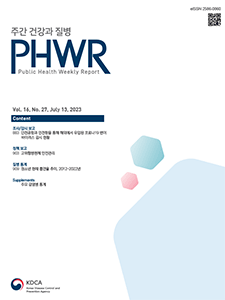Current Issue
Vol.16 No.27, July 13, 2023
-
Surveillance Reports 2023-07-13
 1
1
 1288
1288
 159
159
Surveillance Report of Imported SARS-CoV-2 Variants at Incheon International Airport and Incheon Port (February 15, 2021–March 2023)
Eun-Jung Lee, Sa-Hyum Hong, Sang Oun Jung, Sangmi Park, Young Jee Kim, Jihye Han, Karam Kang, Hanseul Jang, Kyu-Sik Jang, Il-Hwan Kim, Jin Sun No, HyeokJin Lee, Jeong-Ah Kim, Chae young Lee, Eun-Jin Kim, Jeonggu Nam
Public Health Weekly Report 2023; 16(27): 883-902 https://doi.org/10.56786/PHWR.2023.16.27.1 Abstract
AbstractThe Division of Laboratory Diagnostic Analysis of the Capital Regional Center for Disease Control and Prevention conducted variant analysis on SARS-CoV-2-positive samples from the National Incheon Airport Quarantine Station, National Incheon Quarantine Station, and private diagnostic testing centers at Incheon International Airport from February 15, 2021, to March 2023. In total, 13,098 samples from COVID-19 cases from 130 countries were analyzed using the Genomic Surveillance project in the Republic of Korea. They included 12,364 cases (94.4%) of the Omicron family; 658 cases of Delta (5.0%); 55 cases of Alpha (0.4%); 5 cases of Beta; 4 cases of Epsilon; 3 cases each of Gamma, Kappa, and Iota; 2 cases of Eta; and 1 case of Theta SARS-CoV-2 variants. The countries with the highest number of imported cases were Indonesia in 2021 (222 cases, 28.0%), the United States in 2022 (1,942 cases, 17.1%), and China from January to March 2023 (345 cases, 37.3%). Most variants of concern in the Republic of Korea were introduced from various countries. As the importation of recombinant variants generated among sublineages of the Omicron variant increases in 2023, there is an increasing need for genomic analysis through whole-genome sequencing of SARS-CoV-2 variants to enable more accurate classification. Capital Regional Center for Disease Control and Prevention plans to continue to conduct SARS-CoV-2 variant analysis based on a 24-hour diagnostic testing system to effectively monitor the imported cases infectious diseases from abroad and take efficient domestic quarantine measures.
-
Policy Notes 2023-07-13
 0
0
 612
612
 72
72
National Biosafety Management System for High-risk Pathogens
Yunjeong Lee, Jeonghwa Shin, Haeng-Seop Shin*
Public Health Weekly Report 2023; 16(27): 903-908 https://doi.org/10.56786/PHWR.2023.16.27.2Under the Infectious Disease Control and Prevention Act, the Korea Disease Control and Prevention Agency has specified 36 infectious disease pathogens that pose a serious threat to humans and can possibly be used as bioterrorism agents. The agency oversees all national biosafety management processes. This report introduces progress of the national biosafety management system for high-risk pathogens.
-
QuickStats 2023-07-13
 1
1
 1632
1632
 332
332
Prevalence of Current Smoking among Korean Adolescents, 2012–2022
Public Health Weekly Report 2023; 16(27): 909-910 https://doi.org/10.56786/PHWR.2023.16.27.3

pp. 1433~1461
Most Keyword
?
What is Most Keyword?
- It is the most frequently used keyword in articles in this journal for the past two years.
Most Read
-
Waterborne and Foodborne Disease Outbreaks in the Republic of Korea, 2023
Myung-Jae Hwang, So Yeon Park, Hyungjun Kim, Se Jeong Yang, Sungchan Yang, Jin Seon Yang
Public Health Weekly Report 2025;18: 17-32 https://doi.org/10.56786/PHWR.2025.18.1.2 -
Implementation Plan for the Coronavirus Disease 2019 Vaccination for the 2024–2025 Season: Recommendations of the 6th Expert Committee on Immunization Practices
Hyewook Hwang, Wookeon Lee, Seohyeon Ahn, Young-Sook Choi, Seunghyun Lewis Kwon, Dongwoo Lee, Eun Hwa Choi, SokGoo Lee
Public Health Weekly Report 2025;18: 90-102 https://doi.org/10.56786/PHWR.2025.18.2.3
Editorial Office
+82-43-719-7569





 Full Text
Full Text Cite
Cite


